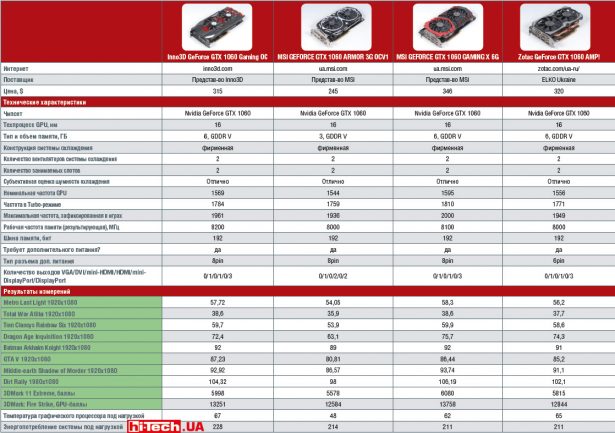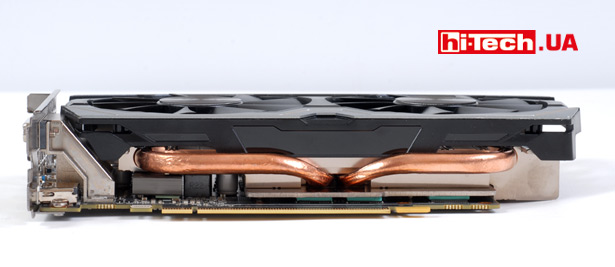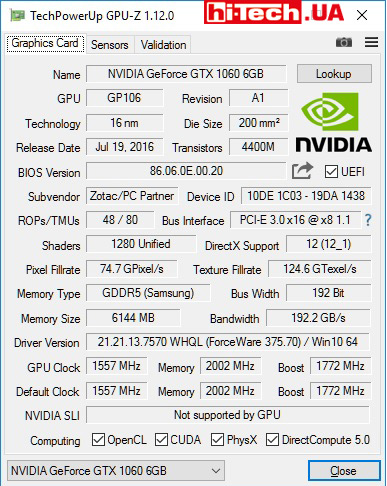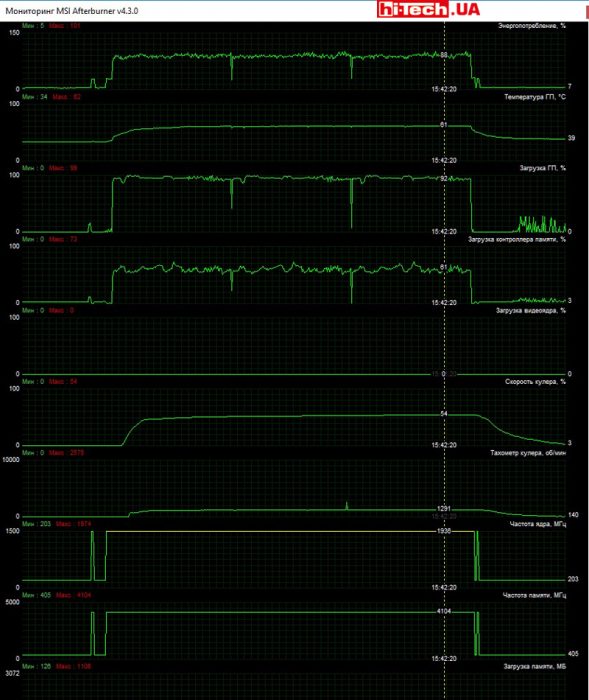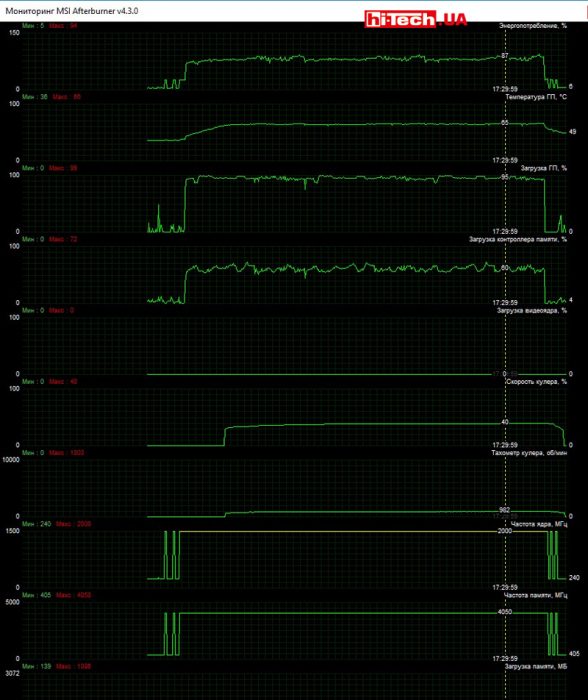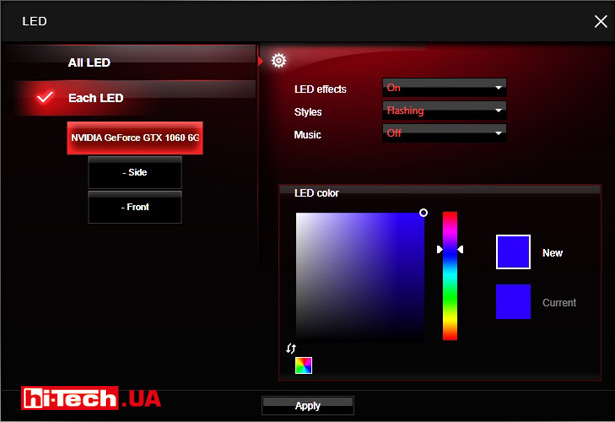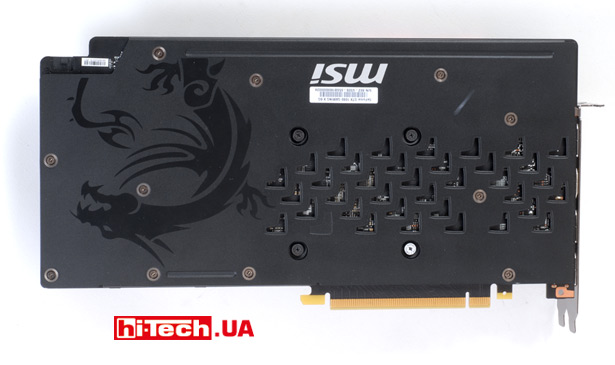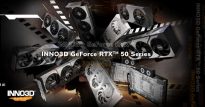Review of video cards based on NVIDIA GeForce GTX 1060 from Inno3D, MSI and Zotac. It’s a chic middle class
25.11.16
GTX 1060 graphics cards have simply excellent performance, functionality and competitive prices. No wonder they are quickly gaining popularity in the market. Our comparative test includes several graphics accelerators based on NVIDIA GeForce GTX 1060 from different manufacturers
See this article:
- Comparison of reference characteristics of NVIDIA GeForce GTX 10XX video cards
- Summary table of characteristics of video cards based on NVIDIA GeForce GTX 1060
- Zotac GeForce GTX 1060 AMP video card! Edition
- Inno3D GeForce GTX 1060 Gaming OC video card
- MSI GEFORCE GTX 1060 GAMING X 6G graphics card
- MSI GEFORCE GTX 1060 ARMOR 3G OCV1 graphics cards
- Description of the test bench and testing methodology
- Histograms with test results
This year, NVIDIA really pleased gamers. Its new video cards of the GeForce GTX 10XX family, which received Pascal architecture, turned out to be very successful. Productivity has increased significantly and energy efficiency has increased significantly.
Compared to the previous generation of video cards (GTX 9XX), you can notice a significant increase in GPU frequencies.
New NVIDIA video cards, combined with also quite interesting new products from AMD, shook up the market, and more interesting solutions became available to users for the same money.
Object of attention – GTX 1060
The first NVIDIA video cards of the new Pascal architecture were high-end solutions GeForce GTX 1080, GTX 1070. A little later, the GTX 1060 model was announced, which can be classified as a middle class, and then the relatively simple GTX 1050 Ti and GTX 1050 appeared.
Functionally, all these video cards are similar. They use graphics processors made using a 16-nanometer FinFET process, support DirectX 12, have a set of more current codecs for hardware video decoding and transcoding, including work with HDR, support modern video interfaces up to DP 1.4, HDMI 2.0b and provide much more more developed capabilities for trendy VR entertainment.
The differences between the GTX 1060 and its older brothers can be clearly seen in the characteristics table. The GPU (GM 106) is simpler with fewer compute pipelines, texture units (TMUs), and rasterization units (ROPs). The memory bus has been somewhat “cut down” with a simultaneous reduction in memory capacity.

Reference characteristics of NVIDIA video cards of different classes of the latest generation, based on the Pascal architecture
Please note that the GTX 1060 6 GB and GTX 1060 3 GB versions differ in more than just memory capacity. There is a difference, albeit very small, in the number of computational pipelines used. This is quite unusual.
It is also worth considering that video cards based on NVIDIA GeForce GTX 1060 do not support operation in SLI mode.
When announcing the GTX 1060, NVIDIA announced this model as a $250 video card with performance on par with the GTX 980. And this is simply an excellent level of performance. Of course, we will check this statement. As for the cost, prices for solutions based on the GTX 1060 exceed the recommended ones, but this is a standard situation, especially since the model is new.
What to expect?
Most GTX 1060 video cards on the market have non-reference cooling systems. Sometimes a shortened board and a CO with one fan are used, and sometimes quite large devices with two or even three fans can be seen. You can expect higher operating frequencies and overclocking potential from such devices.
Video cards are economical, TDP is at 120 W. For additional power, a single six-pin connector is used, but sometimes you can also find options with an eight-pin connector. Several such models are presented in this test.
Cooling systems are also very often used that can completely stop the fans at low loads, and video cards operate silently in such modes.
The standard set of video connectors for the GTX 1060 is one DVI port, one HDMI and three DisplayPorts. This is precisely the configuration that most of the devices discussed in this review have.
Comparing
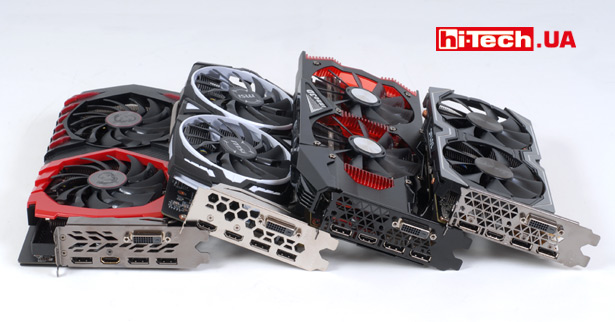
Video cards Inno3D GeForce GTX 1060 Gaming OC, MSI GEFORCE GTX 1060 ARMOR 3G OCV1, MSI GEFORCE GTX 1060 GAMING X 6G, Zotac GeForce GTX 1060 AMP!
For the test, we managed to assemble four GTX 1060 video cards: Inno3D GeForce GTX 1060 Gaming OC, MSI GEFORCE GTX 1060 ARMOR 3G OCV1, MSI GEFORCE GTX 1060 GAMING X 6G, Zotac GeForce GTX 1060 AMP!.
Except for the three-gigabyte MSI GEFORCE GTX 1060 ARMOR 3G OCV1, all the others have 6 GB of video memory on board.
Comparison table of characteristics
ZOTAC GeForce GTX 1060 AMP! Edition
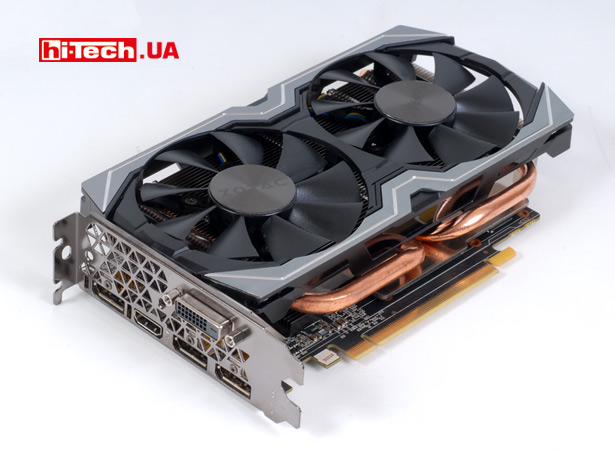
ZOTAC GeForce GTX 1060 AMP! Edition
If you compare this model with other participants, it is noticeable that the ZOTAC GeForce GTX 1060 AMP! Edition turned out to be the most compact.
The proprietary cooling system contains two heat pipes and a radiator, which are cooled by two 90 mm batteries.
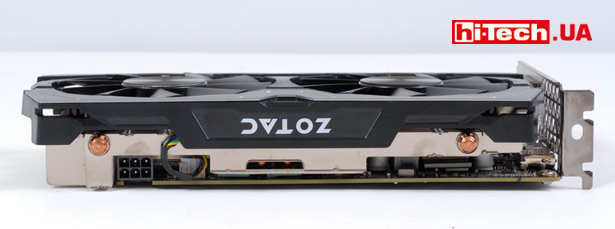
In our conditions, under load, the GPU temperature rose to approximately 70 °C. This is absolutely acceptable, but compared to other participants, this value is the highest. The video card is quiet.
There is a system for turning off fans at low load. The fans turn off and on when the GPU temperature passes 59 °C.
We noticed some peculiarity. Before the final spin-up or stop, the fans go through a mode in which the speed changes from 0 to a certain value every few seconds. Probably the reason for this behavior is the identical temperature thresholds for turning on and off the fans. We assume that this can be fixed in one of the firmwares, although even now it does not create any problems.
AMP prefix! in the name traditionally indicates increased frequencies in Zotac video cards. In this case, only the GPU (graphics processing unit) was factory overclocked. From the standard 1506 MHz (1708 boost), the frequency was increased to 1556 MHz (1771 boost), and the maximum GPU frequency we noticed was 1949 MHz.
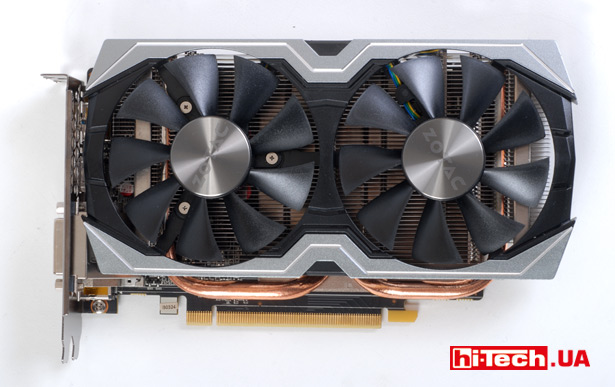
With manual control, the fans can spin up to 3400 rpm. Other video cards have a maximum computer speed of about 1000 rpm.
The fee has been changed compared to the refrain. If we evaluate the degree of “strengthening” of the board by the number of power phases, then from the standard four their number has been increased to five.
Interestingly, the ZOTAC GeForce GTX 1060 AMP! Edition is the only one in the test that has a standard six-pin additional power connector for the GTX 1060. In other boards this connector is eight-pin.

For ease of disconnecting the power cable, the Zotac GeForce GTX 1060 AMP! Edition connector latch has been turned around and a special slot has been made on the board

The video card has a proprietary ZOTAC FireStorm application for monitoring and overclocking, which is very, very similar to the popular MSI Afterburner
ZOTAC GeForce GTX 1060 AMP! Edition provides everything you expect from a non-reference graphics card. It has increased operating frequencies, an effective cooling system and a completely reasonable cost.
Zotac GeForce GTX 1060 AMP evaluation! Edition:
+ relatively compact dimensions
+ quiet operation
+ fans switch off at low load
- GPU temperature under load is higher than that of other participants
Inno3D GeForce GTX 1060 Gaming OC
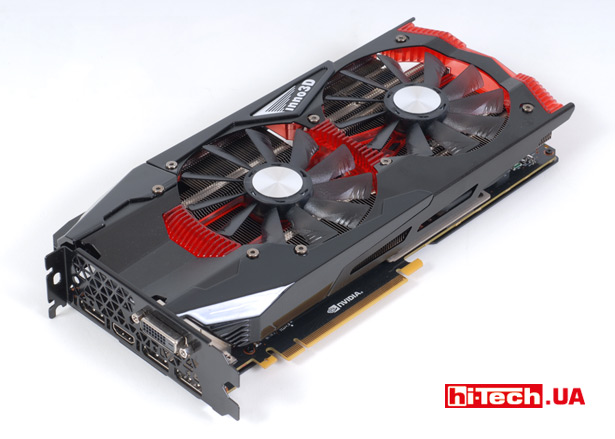
Inno3D GeForce GTX 1060 Gaming OC
The company has prepared a new design for its series of Gaming OC video cards of the GTX 10XX generation.
Both the board and the cooling system of this video card are quite large. In this case, the CO contains two 100 mm fans, although the company often uses CO with three fans in its advanced solutions.

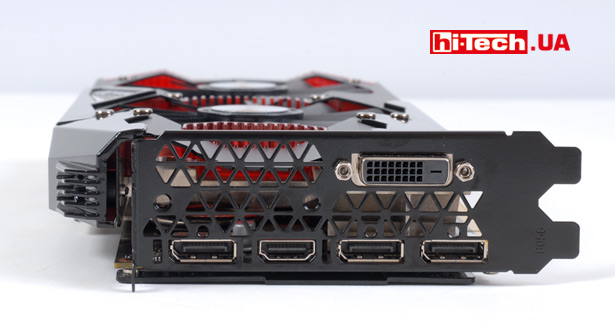
Usually, video card manufacturers only slightly darken the connector panel with anodizing, but in this case the panel is black
Inno3D GeForce GTX 1060 Gaming OC received increased GPU frequencies approximately at the level of ZOTAC GeForce GTX 1060 AMP! Edition, but here the video memory is also “overclocked” from 8000 to 8200 MHz.

Specifications of Inno3D GeForce GTX 1060 Gaming OC (GPU-Z application)
The GPU temperature under load is quite low – 61 ° C. The fans are very quiet.
As expected, the card can turn off the fans if the GPU temperature drops below a certain value, in this case it is approximately 40 °C. By the way, the shutdown occurs in a rather interesting way. First, one fan stops, while the second one begins to rotate very slowly and soon also turns off. Switching back on occurs when the temperature rises to 52 °C.
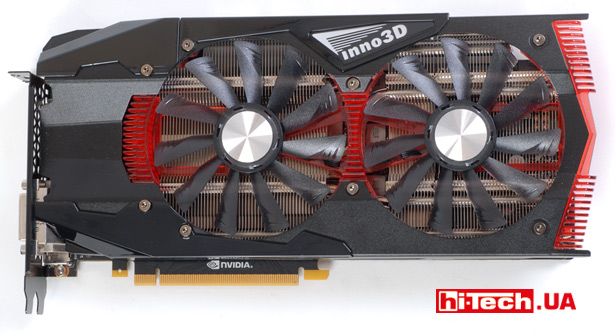
The abundance of translucent elements on the board might suggest that the video card is illuminated during operation, but this is not the case.
The fee has also been changed. Here you can find a six-phase power system. The limit to which the maximum power limiter can be pushed back during overclocking is the highest among test participants (123%).
The board was in second place among other GTX 1060 in terms of performance.
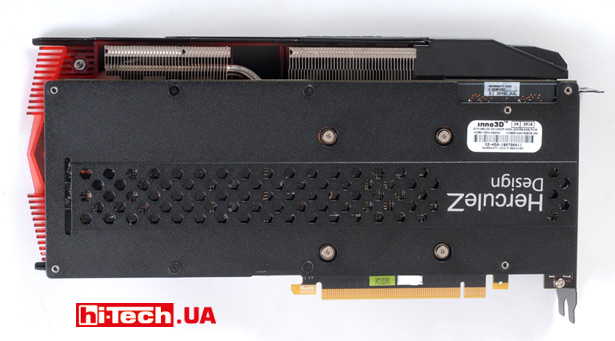
The plate on the back side will help protect the board from mechanical damage.
Overall, the Inno3D GeForce GTX 1060 Gaming OC is a very decent board with a decent factory overclock, a beefed-up board, and efficient CO. We don’t have any comments about it other than its relatively large size.
Inno3D GeForce GTX 1060 Gaming OC evaluation:
+ factory overclocking of not only the GPU, but also the memory
+ quiet operation
+ fans switch off at low load
- the fee is large
MSI GEFORCE GTX 1060 GAMING X 6G
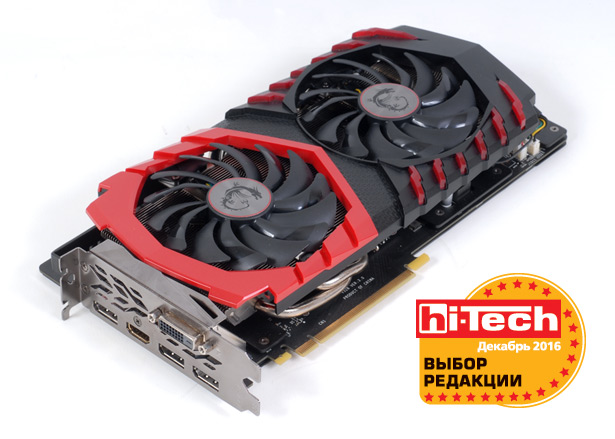
MSI GEFORCE GTX 1060 GAMING X 6G
The MSI GAMING and GAMING X series of video cards is, one might say, a springboard where the company concentrates its achievements and technologies.
This model MSI GEFORCE GTX 1060 GAMING X 6G is today the most top-end and advanced GTX 1060-based video card in the entire large MSI family.
The board, of course, has been redesigned and strengthened. The number of power phases has been increased to six. At the same time, quite unexpectedly, the maximum power limiter can be “pushed back” only to 108%.

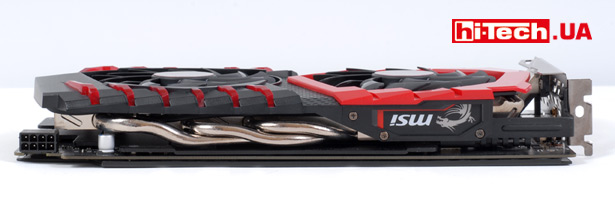
The TWIN FROZR VI cooling system with a series of heat pipes and TORX 2.0 fans does its job perfectly. The GTX 1060 GAMING X 6G turned out to be perhaps the quietest video card in the test, although it should be noted that we have no particular complaints about the other participants.

For this class, we would call this video card large. It has impressive dimensions not only in length, but also in width
Under load, the GPU temperature reaches 65 ° C.
The fans turn off at a temperature of 50 °C, and turn on at 60 °C.
The video card has the highest factory overclock. In games, the GPU frequency can increase to 2000 MHz. Combined with memory overclocking from 8000 to 8100 MHzthis allowed the MSI GEFORCE GTX 1060 GAMING X 6G to become a leader in performance.
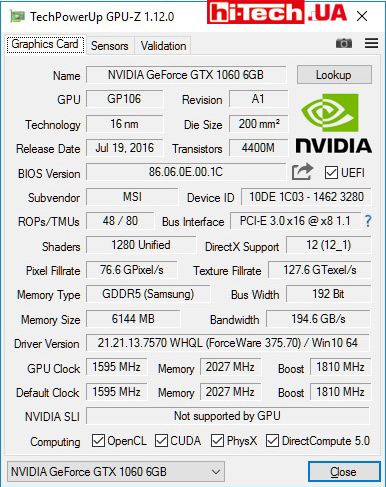
MSI GEFORCE GTX 1060 GAMING X 6G Specifications (GPU-Z App)
Traditionally for GAMING video cards, this model supports work with the proprietary MSI Gaming App. With its help, you can select different operating modes of the video card, slightly different in operating frequencies and fan speeds, control CO, display various diagnostic data on top of the image (FPS, GPU temperature, memory load, etc.), and control the backlight.
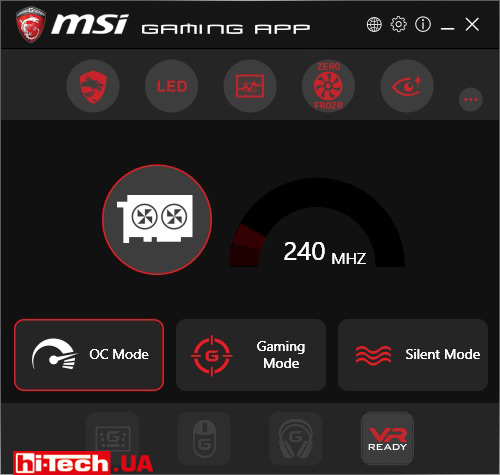
Many of the features available in the MSI Gaming App can also be used via a similar mobile app for your smartphone or tablet.
By the way, compared to the previous generation of Gaming video cards, now not only the logo on the side panel is illuminated, but also the red inserts next to the right fan. In addition, the color of the logo illumination can now be selected to suit your taste.
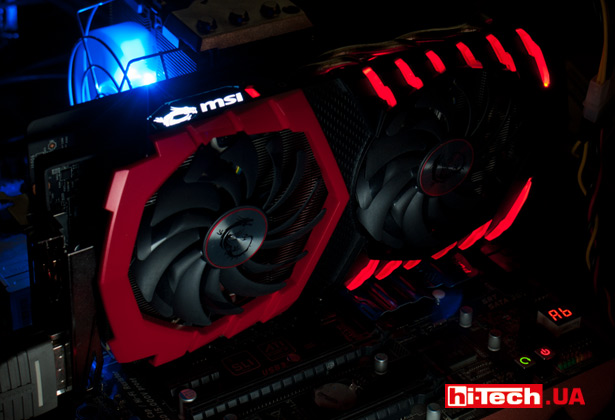
If desired, the backlight can be turned off completely or various effects can be used (fading, flickering, etc.).
As we noted earlier, turning on the OC (overclocking) mode does not always mean increasing the frequencies of the video card. MSI GEFORCE GTX 1060 GAMING X 6G already initially has frequencies corresponding to OC mode.
Among the disadvantages, we should note, perhaps, the rather large size of the board and the relatively high price. This video card has the highest cost among the tested models.
Taking into account all the features, we would call the MSI GEFORCE GTX 1060 GAMING X 6G the most interesting video card in the test. In addition, it outperformed other GTX 1060 cards in terms of performance. Our rating for this model is an Editor’s Choice!
MSI GEFORCE GTX 1060 GAMING X 6G Rating:
+ leader in performance
+ quiet operation
+ fans switch off at low load
+ interesting functional branded application
+ backlight control
- the fee is large
- the highest cost among all test participants
MSI GEFORCE GTX 1060 ARMOR 3G OCV1
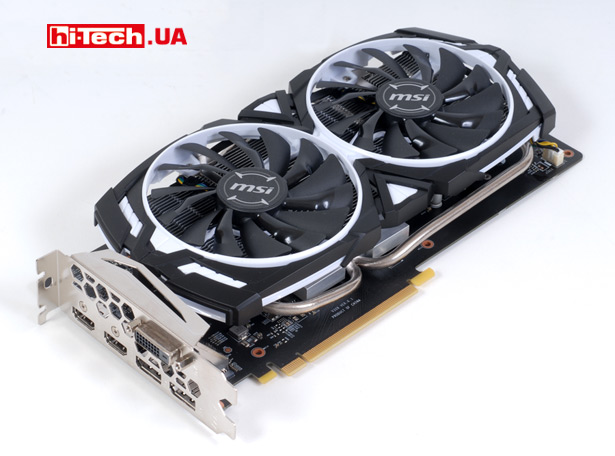
MSI GEFORCE GTX 1060 ARMOR 3G OCV1
This is the only video card in the test with 3 GB on board. Often such video cards have relatively modest parameters, but in the MSI GEFORCE GTX 1060 ARMOR 3G OCV1 everything is at a very decent level. This applies to the board, factory overclocking, and cooling system.
The board is slightly modified compared to the reference one. The power supply system is five-phase.
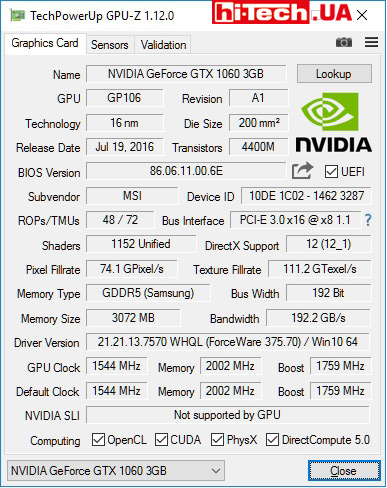
MSI GEFORCE GTX 1060 ARMOR 3G OCV1 Specifications (GPU-Z App)
In terms of factory overclocking, the MSI GEFORCE GTX 1060 ARMOR 3G OCV1 is only just short of the ZOTAC GeForce GTX 1060 AMP! Edition. Video memory operates at standard frequencies.
The cooling system’s performance is absolutely sufficient for efficient heat dissipation and quiet operation. The GPU temperature under load is 58 °C. By the way, this is the lowest temperature among all video cards.
On-site fan shutdown technology. Stopping occurs at a temperature of 45 °C, and starting at 59 °C.
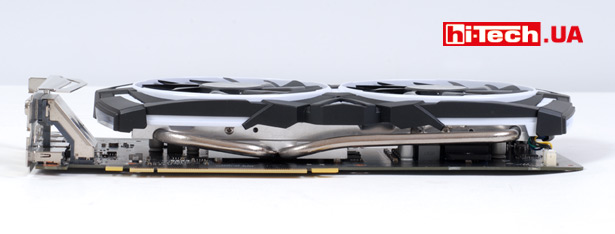
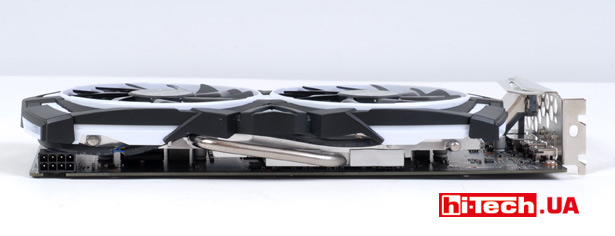

The connector set is a bit non-standard for a video card based on NVIDIA GeForce GTX 1060. One of the DisplayPort ports is replaced by HDMI, and as a result, the set of video outputs consists of one DVI port, two HDMI and two DisplayPort
The most interesting question is what is the difference in performance between this three-gigabyte board and the other GTX 1060 in the test, which have 6 GB of video memory, because the differences in cost between such models are quite noticeable.

The manufacturer decided to install an eight-pin auxiliary power connector on the board instead of the usual six-pin one.
As can be seen from the diagrams, there is a difference, but it is very insignificant and, as a rule, is less than 10%. We dare to suggest that this difference is largely due to the somewhat “lighter” characteristics of the GPU, and not to the smaller amount of memory.
Most likely, when using higher resolutions or any games that require video memory, the difference in performance would be higher, but the Full HD resolution that was used in the tests, in our opinion, is optimal for this class of video cards.
MSI GEFORCE GTX 1060 ARMOR 3G OCV1 may not be as advanced as MSI GAMING and GAMING X, but it is a good balanced video card with far from basic characteristics and a very attractive price.
MSI GEFORCE GTX 1060 ARMOR 3G OCV1 Rating:
+ excellent performance/cost ratio
+ quiet operation
+ fans switch off at low load
- the fee is large
How we tested video cards

Video cards Inno3D GeForce GTX 1060 Gaming OC, MSI GEFORCE GTX 1060 ARMOR 3G OCV1, MSI GEFORCE GTX 1060 GAMING X 6G, Zotac GeForce GTX 1060 AMP! Edition
The video cards worked using the original driver settings; optimized game profiles were not used.
The video cards that were chosen for comparison with GTX 1060-based boards were tested earlier, and accordingly, they have different (current at the time of their testing) driver versions.
As test applications to determine the performance of video cards, we used modern games with built-in benchmarks and synthetic tests 3DMark 11 and 3DMark (2013).
Each game used maximum or high graphics quality settings. In each test application we used a resolution of 1920×1080 (Full HD). For this class of video card, we consider this resolution to be optimal and most in demand. In 3DMark 11, video cards were tested with the Extreme preset, and in 3DMark (2013) the Fire Strike test was used.
To track the maximum GPU temperature and system power consumption (without a monitor), the game Metro: Last Light was used. It was in this game that the video cards, according to observations, heated up the most intensely and the maximum energy consumption occurred. The system itself was operated outside the PC case. The noise level created by the operation of video card cooling systems was assessed subjectively.
Histograms are normalized with models sorted by test results. Specific results in the form of points and FPS are also indicated.
Processor: Intel Core i7-3770K, overclocked to 4.2 MHz
Motherboard: Biostar Hi-Fi Z77X
RAM capacity: 4×2 GB DDR3 1600
Drives: SSD Adata S511 120 GB (system), HDD 1 TB
Operating system: Windows 10 Pro 64 bit
Video cards based on NVIDIA GeForce GTX 1060 were tested with GeForce 375.70 drivers
AMD Radeon R9 Nano graphics card tested with Crimson Edition 16.3.2 drivers
Video cards based on NVIDIA GeForce GTX 960, GTX 970, 980 were tested with GeForce 365.10 drivers
Test results

Все видеокарты на базе GTX 1060 в нашем тесте умеют выключать вентиляторы системы охлаждения, тем самым обеспечивая бесшумную работу при отсутствии нагрузки. Приводим замеры температур GPU, при которых происходят отключение и активация вентиляторов у тестируемых видеокарт

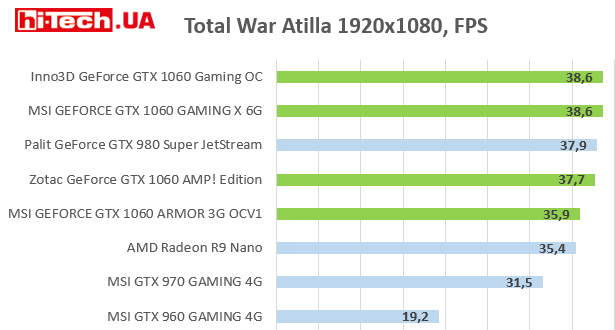
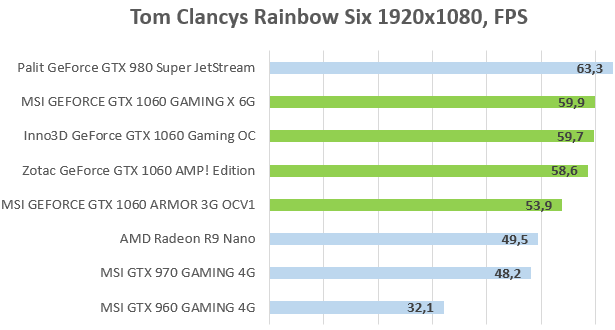
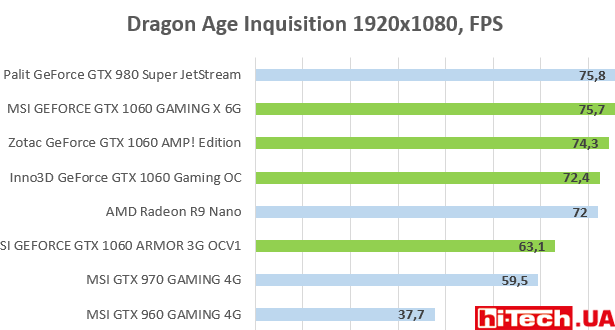
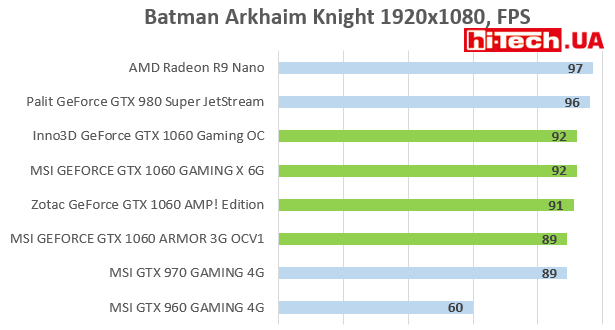
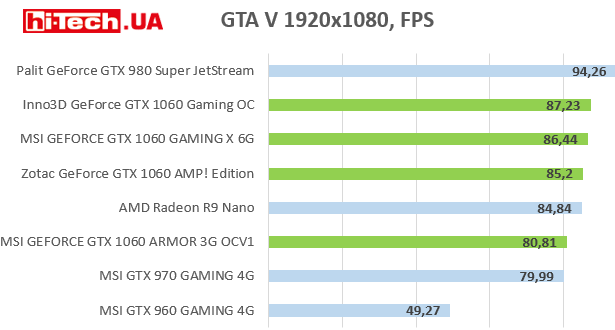

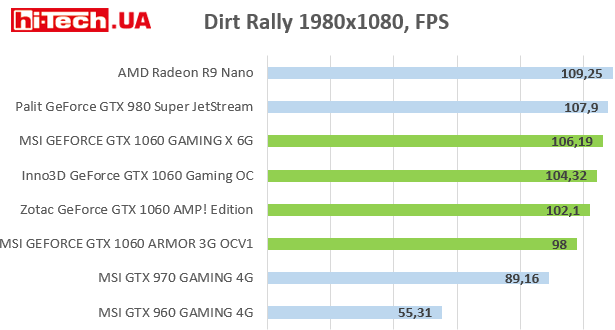
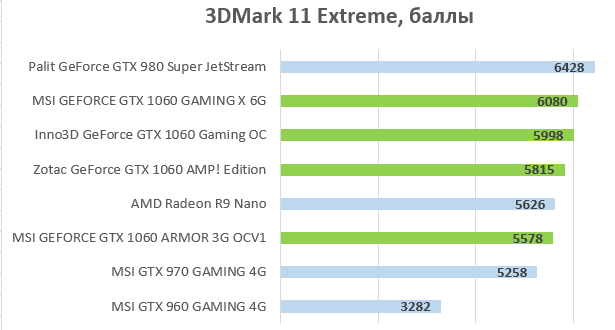

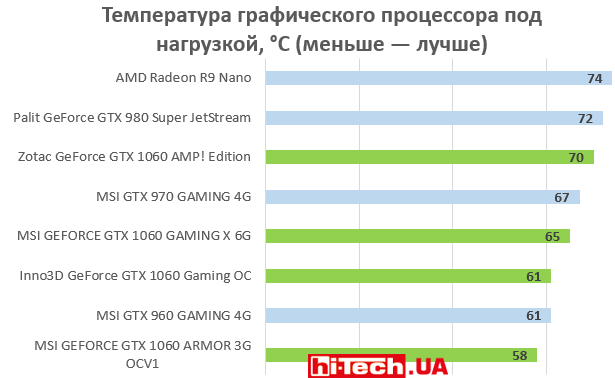
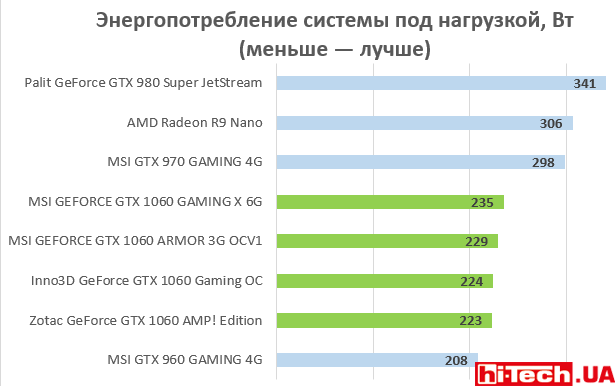
Conclusions
GTX 1060 video cards demonstrated approximately a twofold speed advantage compared to GTX 960. The advantage over the GTX 970 is also noticeable.
What if you compare the performance of the GTX 1060 with the GTX 980? It was not possible to surpass this very powerful high-end video card of the previous generation, but video cards based on the GTX 1060 came close. One should not lose sight of the fact that the role of the GTX 980 was not a reference model, but a very advanced Palit GeForce GTX 980 Super JetStream. We also assume that as the resolution increases, the gap with the GTX 980 may increase.
An excellent opponent for the GTX 1060 would be the AMD Radeon RX video card 480, which was released at the beginning of summer this year, but, unfortunately, we did not get it for testing and, accordingly, it was not possible to compare it with it.
In some applications AMD Radeon R9 Nano turned out to be faster than GTX 1060 video cards, and sometimes inferior to them. Again, let’s assume that by using heavier settings and higher resolutions, the R9 Nano can confidently come out ahead. By the way, the characteristics of the R9 Nano are very close to the AMD Radeon R9 Fury and R9 Fury X.
As for comparing versions of NVIDIA GeForce GTX 1060 with 6 and 3 GB of video memory, based on the results of our tests, we note a very small difference in performance between them. And given the significant difference in cost (at least this is the situation at the moment), the GTX 1060 with 3 GB of memory becomes a very interesting option for users who want to save money on their purchase.
At the moment, 3 GB of memory in this class of video cards looks, in our opinion, quite acceptable, although, of course, a reserve would not hurt. The situation when in some application 3 GB of video memory is no longer enough is quite real today.
The performance offered by the mid-range GTX 1060 graphics card was previously only available in high-end graphics cards. In addition to excellent performance, solutions based on the GTX 1060 are characterized by low power consumption, which means low heat dissipation, and are quiet even under load.
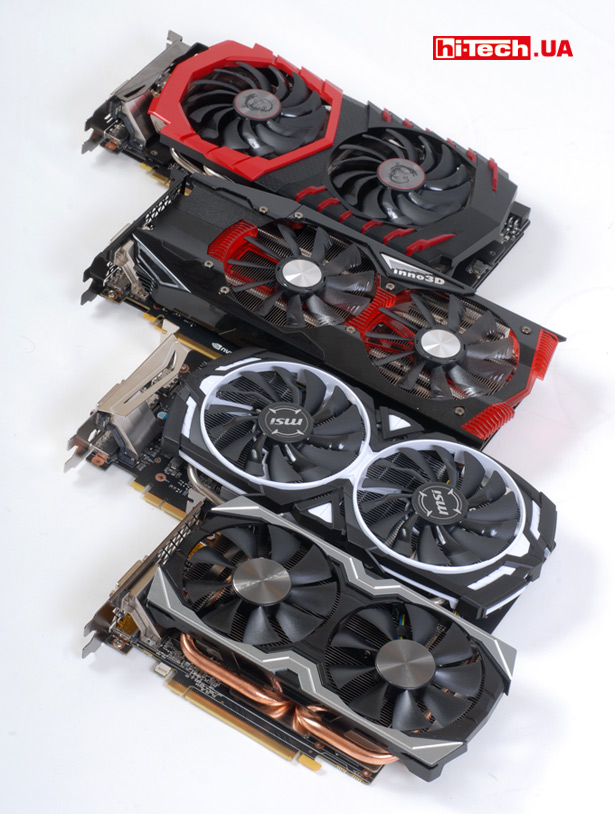
If we talk about the presented video cards Inno3D GeForce GTX 1060 Gaming OC, MSI GEFORCE GTX 1060 ARMOR 3G OCV1, MSI GEFORCE GTX 1060 GAMING X 6G, Zotac GeForce GTX 1060 AMP!, then there are no frankly weak or unsuccessful ones among them.
Whichever model you choose, get a great GTX 1060 solution. Zotac GeForce GTX 1060 AMP! and Inno3D GeForce GTX 1060 Gaming OC are close in cost, while Inno3D demonstrates slightly higher performance, and Zotac is more compact in size.
MSI GEFORCE GTX 1060 GAMING X 6G is definitely the most interesting video card among those presented in the test and also the fastest in speed. True, it costs more than other participants.
MSI GEFORCE GTX 1060 ARMOR 3G OCV1, in turn, is notable for its rather advanced characteristics, which is not so common in three-gigabyte models, and has a very competitive price.
Read also:
- NVIDIA GeForce GTX 1080 and others. Test of mid- and high-end video cards
- Testing the AMD Radeon RX 460. Budget video cards are getting faster
Engineer of the Test Laboratory
Don't miss interesting news
Subscribe to our channels and read announcements of high-tech news, tes
Oppo A6 Pro smartphone review: ambitious

Creating new mid-range smartphones is no easy task. Manufacturers have to balance performance, camera capabilities, displays, and the overall cost impact of each component. How the new Oppo A6 Pro balances these factors is discussed in our review.
Editor’s Choice 2025. Best devices of the year by hi-tech.ua

The best gaming laptops, mice for work, gaming keyboards, smartphones, and wireless headphones of 2025. Among them, we will highlight the most interesting ones and those that we can recommend buying.
Michelin has created a real-time tire monitoring system car CES development
Michelin is preparing to introduce a new line of “smart” tires capable of real-time
BYD showed ultra-fast charging for electric cars: 400 km in 5 minutes charger development electric transport
BYD is one step closer to its goal of making electric vehicle charging comparable in speed to refueling vehicles with an internal combustion engine

